Ochanomizu Station Signals
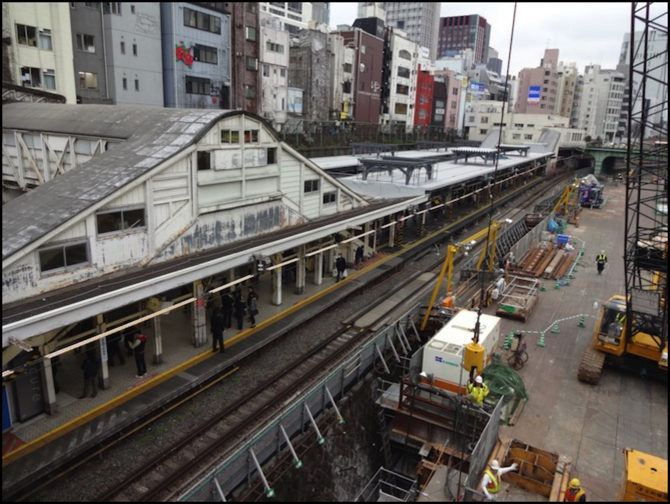
Photographer: George Roberts (used by permission)
My previous post may be a bit stale now, as in the course of looking at what was going on just to the east of those crossovers, I learned a whole lot more about signaling on this line in general. So while most of today’s post concerns Ochanomizu Station, there are related changes to what I know about other stations on this line, and the block signals of the line itself.
JR’s Ochanomizu Station (御茶ノ水駅, Ochanomizu-eki) is an important part of my modeling plans. As seen in the photo above, it’s a mix of old and new architecture. And it’s built along the bank of the Kanda river (the temporary construction platform on the right is actually erected over the river). It’s slightly below street level, with a city skyline climbing up behind it from a front rank of buildings around six stories in height to taller ones further away. It’s pretty much ideal as a modeling subject visually, and it sits at the junction of two busy lines, so there is a lot of activity.
I have been trying to figure out how the signals here and nearby work so that I can include a reasonable subset in my model, but photos in and around the station tend to focus on other subjects than signals for some reason. Thanks to one of my readers, George Roberts, I now have a number of photographs taken around the station and adjacent areas that include these signals (and other interesting details). Rather than link to copies published by him, which is my usual approach for third-party pictures, for bandwidth purposes I’m going to link to copies on my site for the ones I use to illustrate specific points. Click on any of these inline images to see my copy of the full-size version.
As I’ve mentioned before, the station is composed of four tracks, and sits at the junction of the Chūō and Chūō-Sōbu lines. To the west there are four parallel tracks, two for each line. The Chūō line (also known as the Chūō Rapid line) is an express line here skipping most stations, while the Chūō-Sōbu line has stations every kilometer or so. To the east two tracks run through Akihabara as the Chūō-Sōbu line, eventually crossing the Sumida River and running through Koto Ward as the Sōbu line, while two others curve to the south as the Chūō line, running through the former Manseibashi station just east of Ochanomizu and eventually terminating at Tōkyō station several kilometers distant.
In the station itself, the Chūō line tracks are on the outside, with the Chūō-Sōbu tracks in the middle. The eastbound tracks are on the north (river) side, while the westbound tracks are on the south (road) side. Island platforms sit between the two eastbound tracks and the two westbound tracks. Just to the west are a series of switches that eventually put the Chūō-Sōbu tracks adjacent to the river and the Chūō Rapid tracks south of those. And just to complicate things further, west of the station the tracks are apparently used bi-directionally, something that’s very rare in Japanese double-track urban railroads.
As the Chūō-Sōbu tracks leave the station to the east they are already climbing relative to the eastbound Chūō Rapid track, with a grade of 3%, quite steep for a mainline railroad that used to carry freight, even if it is only for a short distance. Then they make a sharp turn to the left, cross the river, and run on a high viaduct between even taller buildings to reach Akihabara station. In the same direction, once away from the crossing Chūō-Sōbu line, the Chūō Rapid tracks curve slightly to the right before running over the roof of the former Manseibashi station, now a restaurant, and then run along a fill that curves off to the right between tall buildings. In short, it would be very easy for both sets of tracks at the east end of the station to disappear into a backdrop in gaps between a couple of buildings. That’s an aspect I may take advantage of when I eventually model it.
As you can see from the photo above, there’s a lot of construction going on right now. I’m not really sure what they’re doing, but some of it appears to be reinforcing the embankment walls, which date from the 1920s or earlier. The work extends well west of the station. There are also some modifications being made to the station itself. I’m going to skip over that here. Today’s subject is the signaling system, and this is basically a continuation of my previous post on the Chūō Line, discussing the prototype before I get around to trying to simplify it for the layout.
The main signals around the station are a mix of three- and four-lamp signals, with two five-lamp signals on the westbound Rapid line approaching the station. In addition to these there are a variety of other signals serving special purposes (not all of which I understand).
For simplicity I’m going to abbreviate the tracks from north to south as CRE (Chūō Rapid Eastbound), CSE (Chūō-Sōbu Eastbound), CSW (Chūō-Sōbu Westbound) and CRW (Chūō Rapid Westbound).
Signals Types
There are three basic categories of signals to consider here: the large signals used to control trains normally, the smaller “shunting” signals used to control certain kinds of movement in the vicinity of the station, and “call on” signals that allow a train to be “called” into an occupied section of track (used when two trains need to share a platform that isn’t subdivided, for example).
I’m going to concentrate on the larger signals, which show aspects that are basically speed-related. The reality is more complicated than that, but for now consider them as indicating speed. Trains running on the Chūō Rapid line are limited to a top speed of 100 kph (about 60 mph) today, while the Chūō-Sōbu Line serves a mix of services (some of which run through stations at speed without stopping). A “Clear” (single green light) aspect thus allows a train to run at its maximum speed up to the track limit of 100 kph, unless that section of track has a lesser limit (usually posted on a sign, but memorized by the drivers anyway).
All signals can also show “Caution” (a single yellow lamp), indicating a limit of around 40 - 55 kph (it varies by line, and I don’t know the specific limit here) and “Stop” (a single red lamp), which is an “absolute” form of stop that cannot be passed until it changes (except when authorized by a call-on signal or some equivalent command). Some lines do use permissive stops, but that’s very rare now and I doubt this is one of them.
Some signals can also show other aspects. Signal types 4A and 5A (see the aspects page for an explanation of the type numbers) can show Restricted Speed (two yellow lamps arranged vertically), which limits trains to the speed at which they can stop short of an obstruction, and no more than 25 kph (15 mph) in any case. This is used when entering a station platform where a train may be stopped ahead (but in a different section of track; it can’t call a train into an occupied track section as far as I am aware). And signal types 4B and 5A can show two aspects allowing higher-speed operation, a “Reduced Speed” (yellow above green) limiting trains to around 50 - 75 kph (31 - 46 mph) and “Less Reduced Speed” (yellow over green flashing together), limiting trains to around 105 kph (65 mph). Since the latter exceeds the allowed top speed, this aspect wouldn’t be used here, so a type 4B is only going to add the Reduced Speed aspect.
All of these signals are tied into track occupancy detectors, so they won’t allow two trains to enter the same section of track, or to follow each other closely at high speeds. Some of the ones away from the station are probably entirely automated, but the ones in the station will allow human control up to a point, by either local staff (the “station master”) or someone at a CTC panel in a remote control center (I say panel, but it’s all CRTs and mice these days; I doubt JR East has any big green USS machines left on a line this important).
There are also a number of other special indicators, subordinate to the signals, but I won’t say a lot about them because I don’t really understand how they’re used.
Block Signals
Signals outside of a station are “block signals”, which are normally entirely automatic. However, in CTC-controlled areas these may have an additional layer of control by remote staff. Signal aspects will always be restricted by local circuits depending on what trains are ahead, but may be further limited by human control. This is particularly likely where bi-directional running is used, and the Chūō Line is reported to use CTC (I suspect that applies to all four tracks), so all of these signals may have additional human control.
But at a minimum, signals will be red if the next block is occupied, and some other aspect if a train is two or more blocks away. A train needs to be several blocks ahead before a signal can turn green. My guess is three, given the use of Reduced Speed in addition to Caution, but I don’t know that for certain, and in some places there’s no option for Reduced Speed, which may indicate that only two blocks are needed, due to a combination of speed limits and longer blocks.
In the full set, the signal progression as a train moves away would be from “Stop” (red) to “Caution” (yellow) to “Reduced Speed” (yellow above green) to “Clear” (green). I expect “Restricted Speed” is not part of this progression, as it usually isn’t in other signaling systems I’m familiar with. That aspect only gets used for places where trains have to be limited through switches or due to other conditions. But aside from one English-language paper written by JR staff that described a “typical” use, I haven’t seen anything that states how block signals progress.
Block signals are generally designated by some kind of number plate (using western “arabic” numbers) attached to the signal mast, with numbers that grow sequentially from 1 between stations (or decline towards 1, depending on the direction), and reset after the station. Non-block (i.e., interlocking) signals will have nameplates with kanji descriptions of the signal’s role mounted above or to the side of the signal (or rarely, below it, but visually distinct from a number plate), or at least they do here.
I don’t have any good photographs of block signals on the Chūō-Sōbu or Chūō Rapid lines, but they look a lot like the one below. Note the small number plate below and to the left of the signal head (the thing next to it with the red cap is a warning flasher, that indicates a problem on the tracks ahead, such as a pedestrian fallen off a platform, and I think the sign with yellow letters goes with that).
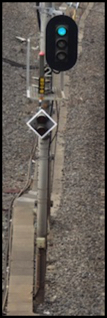
Block Signal (block #2), Joban Line, Nippori Station
Photographer: George Roberts (used by permission)
The diamond-shaped head below the emergency flasher on the signal above may be some kind of call-on signal, as I’ve often seen them around stations and rarely on block signal masts. However I’ve never seen one lit, so I can’t be sure of their function.
On the Chūō Rapid westbound line (the only one for which I have good information), the block signals start at 14 just west of Ochanomizu, and count down to one as you approach Shinjuku station (they do not reset when passing through the one intermediate station where the train stops). On this line, the block plates are black plates with white numbers, similar to the example above. Elsewhere I’ve seen numbers inside the black and yellow triangle markers on the signal mast, but on this line I only saw those on posts in between signals (giving the number of the next signal).
Home and Starting Signals
Stations have a couple of special uses for the large signals. In addition to showing aspects that depend on how far ahead the next train is, they can also be controlled by someone at the station (the Station Master) or by someone in a remote control center. Signals at the entrance to a station, called “Home” signals, will remain red, holding trains outside the station, until the platform is ready to receive the train. Before a train can depart the station, the signal at the exit, called the “Starting Signal” must (normally) be manually cleared (it won’t actually change from red if another train is too close, but it will stay red unless cleared even if the track ahead is empty).
I expect the control system can be set to automatically clear the starting signals, probably based on scheduled departure times as part of JR’s train scheduling system, which I’ve seen vaguely described in a couple of papers, but again I don’t know that for certain.
Within a station there can be multiple home or starting signals, particularly where a line splits into multiple tracks that need to re-join before exiting the station. And as we’ll see, sometimes multiple home or starting signals are used just so trains entering or leaving a station can be queued up away from the platform. Long platforms can also have intermediate home signals used to position a train behind another train on the same platform. Ochanomizu, despite not having multiple tracks per line, actually has all of this complexity.
Station Signals
Let’s look at the specific signals within Ochanomizu station now. Each of these has a purpose operationally, and is capable of displaying aspects that are related to that purpose. All of these can also presumably function as block-like signals for trains running through the station at speed.
Station Entry Signals
Unfortunately photos of these are hard to come by, as they’re outside the station and facing away from the platforms. I’ve managed to track down photos of several of these via Google Earth (both on Panoramio and Street View), but as those images are copyright I won’t reproduce them here. I do have one from George’s set though.
The purpose of a station-entry signal is to admit a train into the station. These are human-operated signals, although they’re also tied into the track circuit system (so they can’t admit a train into an occupied track; you need a “call-on” signal for that). These would not normally be part of the block signal system although they are “home” signals (in Japanese signaling, home signals may or may not be part of the block system, from what I can tell). Notice the black plate with white kanji notation above the signal, that’s its “name” (I’m not sure what it’s called for real). You see those associated with all station signals on this line, so I think it designates a label used by the station staff to unambiguously refer to a specific signal.
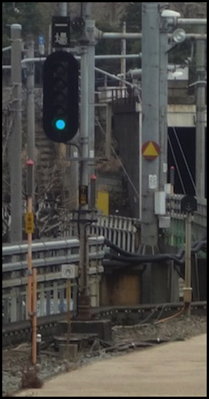
Photographer: George Roberts (used by permission)
This is the home signal, or I should say the first home signal, on the CRW line. It’s located adjacent to the old platforms of Manseibashi station east of Ochanomizu station, which have now been turned into a restaurant, making photography of the track here much easier than it used to be, as long as you are careful about window reflections. This is a very interesting signal. It’s a type 5, and I presume a 5A as the 5B is only needed for authorizing 140 kph operation, which exceeds the line speed limit here. This means that it can show both Reduced Speed (for high speed operation through the station) and Restricted Speed (for approaching a station where there may be a train just past the next signal). It’s marked with a sign bearing the kanji “一” (ichi), meaning “one” as well as the kanji for “home” type signals (“場”, translates as “place” but is the first character of the word used to identify a home signal). All fine so far, although it’s located pretty far away for a home signal.
But there’s also a second home signal on CRW just before the platform (you can see it from the adjacent street on streetview), around the curve from the first. I’d have expected the first to be a repeater (i.e., showing the same aspect as the next signal as an advance warning), but there’s nothing here that indicates that it is. Like the first it is a type 5, and is marked as a home signal, but this one bears the Kanji “二” (ni), meaning “two”. So it appears that there are two consecutive “home” signals outside the station, to hold two trains short of the platform, which may be useful at peak times. This likely also explains why ichi is used on all of the starting signals on the platforms (see below).
I don’t have good photos of other entry signals here, but there’s one fuzzy one on Panoramio of the CRE entry signal that appears to use “ichi” as the middle of three kanji (I can’t make out the other two).
Mid-Platform Signals
The station is about 250 meters in length, but not all of that is usable platform today. There are signals at about the midpoint on the station, but they’re not at the middle of the usable platform. A typical 10-car train is going to use nearly the entire platform length, so these signals are probably only useful for trains off-peak or specialized trains that need less platform space. They may also be there simply to expedite the entry of a following train, since a departing train will clear their track section long before it actually exits the station.
The photo below is of the same section of the platform as the photo at the top of the page, looking at the CRE platform, but this time looking east along the platform. The deck in the foreground is the temporary structure the crane is parked on, above the river.

Photographer: George Roberts (used by permission)
In the photo above you can just see one mid-platform signal (the red dot left of center) near the rightmost yellow arch on the eastbound Chūō line. Perspective is a bit misleading here, as the signal is actually closer to the stairs for the overhead passage than it appears. Signals on the Chūō-Sōbu line are at about the same place, but the signal for the westbound Chūō Rapid line is almost under the bridge on the far side of the overhead passage.
The platform extends under the concrete bridge at the left end of the photo, while the stairway at the right of the image marks the end of the usable platform on this line, and there’s about 90m of platform for a train stopped at this signal (about four cars), while a train ahead of it would have close to 120m of platform (around six cars).
These mid-platform signals on the eastbound lines are both three-lamp signals, while the westbound signals are both type 4. The set of photos below show (L to R) the CRE, CSE, CSW and CRW signals. Note that the two CS signals have a yellow triangle next to them, while the other does not. From what I’ve been able to puzzle out from various online sites, this symbol, known as a “signal kanko-i” (信号喚呼位) designates a signal as an important one that needs to be verbally acknowledged (part of the “pointing and calling” behavior required of Japanese train drivers). Why this only appears on the CS signals is a mystery though (and see more about those in the section on starting signals below). And in video of the CRW line, I’ve seen the driver pointing and calling at signals without the symbols.
As an aside, these yellow triangles are also used as for signal block number identification, where the number in arabic numerals (i.e., “12”) will sometimes be written inside the triangle.
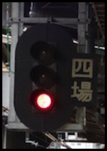
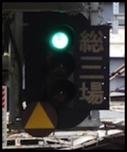
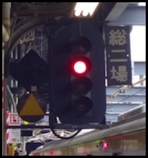
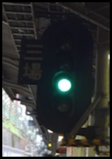
Photographer: George Roberts (used by permission)
The bottom kanji on the sign identify all as “home” type signals (“場”, translates as “place” but is the first character of the word used to identify a home signal). The top-most Kanji on the left (4) and the middle Kanji on the others (3, 2 and 3, respectively) designate the sequence of these signals (i.e., the rightmost signals is the third home signal along the Chūō Rapid westbound line; we’ll see the first in the Home Signal section). The top Kanji on the two CS signals, “総”, is the first character of the name Sōbu (総武), which I presume identifies these as signals for the Sōbu line. Why the Rapid line lacks a third symbol is a mystery.
Interestingly, although the CSW signal is designated as “4”, and I’ve spotted signals “1” (shown above at Manseibashi) and “2”, I haven’t seen a “3” anywhere and I don’t think there’s enough space for one. Yet another mystery.
I’m used to seeing block numbers on signals written in arabic numerals rather than kanji, but they seem to be consistent about doing it this way at Ochanomizu and other stations on this line (although there’s one example of an exit signal with an arabic block number plate on it). I suspect it is to differentiate these from block numbers, to avoid any confusion.
Starting Signal
A starting signal is a signal at the exit of a station used to signal the operator that it is permissible to leave the station. These signals are usually under the control of the station master, but are also tied into track circuits and in some cases will function as a block signal (not always, sometimes there is a block signal just outside the station). Starting signals seem to be universally identified with the Kanji “出” (literally “out” or “exit”), often along with a sequence number similar to what we’ve seen with the home signals.
What’s interesting here is that both of the signals for the Chūō Rapid (tracks 1 and 4) use the Kanji “一” (ichi) for the number 1. I think this is because they’re the first starting signal on each line, similar to the entry signal above. The one signal I can read for the Chūō-Sōbu (eastbound) uses the same Kanji as the mid-platform signals (総), but lacks a number. The signal for the westbound Chūō-Sōbu is hard to read for certain (it’s in a dark location under the bridge, see photo further down), but I think it has three Kanji, the “Sō” indicating the line, the ichi indicating sequence 1 and the starting signal Kanji. The absence of a sequence number from the CSE signal is another mystery, but it probably means that there is only one starting signal on this line and the next signal is a block signal. Unfortunately, the next signal is on the bridge above the river and I haven’t seen any photos clean enough to read its sign.
Although I don’t have a photo of it (it’s on Panoramio), west of the station on CRW there is a signal with two heads for the crossover around the curve. The plate above the through route head has “出” as its lowest kanji, and the one above that is a “ni”, making it a second starting signal rather than a block signal (i.e., it exists to allow a train to wait short of the crossover while still being technically part of the station and presumably under a degree of local control). I can’t make out the top signal, but I suspect it refers to the line name. The diverging route head bears an entirely different pair of kanji though, which I can’t make out in any photos I’ve seen.
Int the photos below, L-to-R we have the CRW, CSE and CRE line starting signals at the ends of their respective platforms. Also note that here we have the yellow triangle only on the CRE signal (it’s possible that there’s also one on CSE, as I can’t see left of the mast due to the side of the building).
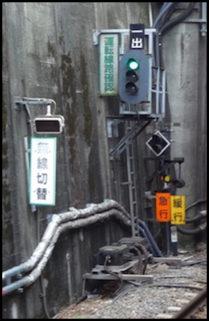
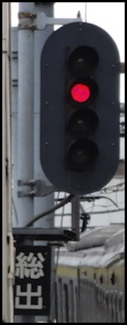
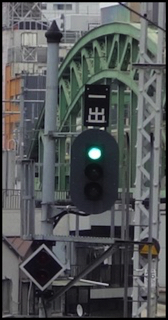
Photographer: George Roberts (used by permission)
Also of note here is the CSW uses a 4B signal here, which can show the Reduced Speed aspect. I suspect the reason is due to the sharp curve leaving the station, and several short blocks before the next station, making it possible that there could be trains close ahead. The next block, in fact, only extends about one train length, to a signal just before the bridge over the river.
The CSW signal, below, has some other puzzling elements. First, the two while lights below it look like route indicators, but there’s no choice of route here (no facing point switch) unless this applies to a crossover more than a kilometer away. Second, both are lit, and my understanding was that these were exclusive, and no more than one could be lit.
This mast also bears a shunting signal (the two smaller white lights arranged horizontally). This at least makes sense, as there’s a trailing point crossover just ahead, which would allow a train on this track to reverse direction back into the station on the other track. This enables trains from the Sōbu line to be turned back here, which seems like a reasonable thing to do. And it has one of those two-light diamond-shaped signals (which perhaps are a form of call-on signal; I can’t be sure).
Finally, there’s a small blue-white light at the bottom. I’m not sure what it is. It might be a call-on signal, but if so it shouldn’t be lit if the signal is already green (that’s redundant). It could be a light unrelated to the signals (i.e., on something behind the mast the just looks like part of it from this angle).
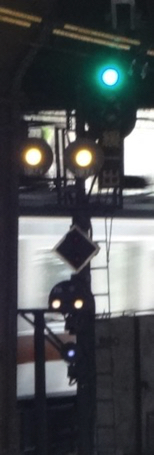
Photographer: George Roberts (used by permission)
Shunting Signal
sShunting signals are simple position light or color position light signals showing (typically) two aspects, caution (diagonal) or stop (horizontal). They’re tied into track occupancy circuits, so they can’t admit a train into an occupied track. Aside from that, they’re under human control (likely either the station master or the remote center can control them, but I don’t know for sure).
The photo above of the CSW starting signal shows a shunting signal with two lunar white lights displaying “stop”. These are mounted on a semi-circular head that’s attached to the mast of one of the larger signals. That’s very common, although shunting signals can also be placed on short posts at ground level or on their own tall posts.
Shunting signals are only needed where there is a need to operate a train at low speed in a manner normal signals would not allow. For example, the one on CSW could allow a train into the track just outside the station to use the crossover for a reverse move into the station, even if there was an oncoming train a couple of blocks out that prevented the normal signal from being used to send a train west on the line.
Operational Implications
You can infer a lot about how trains operate here based on these signals.
First, you can have trains that come from Akihabara (and the Sōbu line east of there) and turn back at Ochanomizu. That’s an interesting bit of operational complexity, likely involving the use of shunting signals operated by the station master or a remote dispatcher to run the train west of the station and then back through the single crossover to the eastbound Chūō-Sōbu station track.
Second, it’s pretty clear that at least on the westbound Chūō Rapid line, express trains can run through the station at speeds up to 75 kph. They probably don’t go any faster, or they wouldn’t need a special signal and could just use a simple three-aspect signal. Why the same isn’t true of the eastbound line (which has simple three-aspect signals) isn’t clear. It may allow run throughs, but just not limit their speed.
However, near the exit of the station there is what appears to be a speed limit sign marked “55”, so it’s possible trains can run into the station faster, but must slow down within it, or perhaps “medium” (yellow) refers to some speed below 55 kph, and (it normally applies limits between 40 and 55 kph) and Reduced Speed (yellow above green) means 55 kph here.
There’s also the ability to hold a pair of trains outside the station to the east on the CRW line on approach, and to hold one more on the outbound track to the west (up to four trains in or near the station at once assuming the fourth fills the platform). It’s possible the eastbound line is set up similarly, as there are two signals to the west of the station on approach, although they don’t appear to be marked as two sequential home signals, but I don’t have very good photos of them.
On top of that, we have all the crossover switches to the west, which allow westbound trains from either Tōkyō or Akihabara to use either the westbound express track or either track of the local line (but not the eastbound express track; it’s unreachable). In the other direction an eastbound from any track can reach either of the westbound tracks to Tōkyō or Akihabara, again with the exception that trains on the westbound express line can’t cross over to the eastbound express line to Tōkyō.
Considering that this is just a simple station with four through tracks and no switches inside the station, that’s a pretty amazing amount of operational complexity.
One other thing that comes out of this. I’d thought initially that the reason for the type 4 signals had been to permit Restricted Speed (25 kph, 15 mph) operation through the crossover tracks. I’ve reconsidered that. As far as I can tell, a number of the possible routings have no aspect more restrictive than Caution, which is the usual aspect used for a medium-speed switch. Thus, despite these double-crossovers looking fairly sharp, I think they’re probably rated for 40 kph (25 mph) operation.
Other Signals
There are a bunch of other signals visible in these photos that I haven’t described in today’s post. One type may apply to “wrong way” running, although I’ve seen similar signals used at crossovers as apparently some kind of “safe to pass” signal. And there are some mystery lights inside the station. I’ll probably do a separate post on those in the future, as this post has already become quite long. And at some point I want to update my maps of which signals are where, and add the new information about type and the signs to them. I expect I’ll have a few more posts about this line before I’m done.
Summary
Thanks to George’s photos, I have a much better understanding of the signals at Ochanomizu and along the associated lines than I did even just two weeks ago. It’s really driven home how much information I’d missed even with the copious photos I had been able to locate through other sources. Those gave me lots of good information on track layout and structures, and a little on signals. But most people just don’t photograph signals very clearly, if at all, and there were many little details I’d never observed before now.
That’s useful knowledge in its own right. This isn’t the only line I want to include in the new layout. And now I know what kind of detail to look for when I start investigating those. Considering that I’m really only just getting started on planning the new layout this spring, and I’d said a year ago that I expected to have a plan by now, I’m moving fairly slowly. But I’m not really in a hurry, and it could easily be another year before I set saw to wood and begin construction. That’s not really a problem. On the original Sumida Crossing I spent about six months planning before construction started, with two to three months of detailed track plans (and many revisions to those) at the end of that. I want this layout to last longer than the last one, and I aim to be more careful in its design, so it was always going to take longer.



